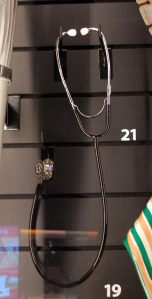A common symbol often associated with the medical field is a stethoscope. This device is often seen hanging around the necks of medical personnel. The stethoscope was invented in 1816, by a Frenchman named Rene Theophile Hyachinthe Laennec. The notion of listening to internal sounds of the human body is called auscultation. Before devices like the stethoscope, listening to internal sounds was done by placing ones ear on another persons body, this is called immediate auscultation. Laennec came up with the idea for the stethoscope when he was too embarrassed to place his ear on a young woman’s chest. Instead he used the concept of sound traveling through solids and rolled 24 sheets of paper, placed one end to his ear and the other end to the woman’s chest. To his surprise it worked and the sounds were loud and clear, this is called mediate auscultation.
The name for the device was not always stethoscope. In fact, Laennec preferred the device be called “Le Cylindre” but believed the device did not need a name. After his colleagues began to give it random names he decided that if the device was going to have a name it would be stethoscope. The name comes from the Greek words of stethos (chest) and scopes (examination). At that time the stethoscope was a wooden cylinder and looked similar to a hearing aid in use at the time, known as the ear trumpet. The device would look this way until 1851 when the stethoscope was made to be used with both ears, or binaural. This was made possible due to the invention of rubber. George Phillip Cammann is credited for the binaural stethoscope after he published specifications for the model in 1853. Today it is one of the most recognizable pieces of medical equipment.
This stethoscope belonged to Dr. Francisco Gonzalez Cigarroa a native of Laredo, Texas. One of ten children, Cigarroa attended J.W. Nixon High School and later Yale University. Cigarroa received a bachelors in biology and his medical degree from The University of Texas Southwestern Medical Center at Dallas. Dr. Cigarroa was chief resident in General Surgery at Massachusetts General Hospital. In 1995 Dr. Cigarroa joined the University of Texas Health and Science Center at San Antonio as the director of pediatric surgery and was president from 2000-2009. In 2009 he became the first Hispanic to become chancellor of the University of Texas System. Dr. Cigarroa is known nationally as a prominent transplant surgeon.
Today the future of the stethoscope is up in the air. As new technology is integrated into the medical field many have begun to wonder if the stethoscope has run its course. Doctors rarely reach for the stethoscope when trying to figure out what the problem is. Instead doctors choose devices like the echocardiogram, as well as small pocket sized ultrasound devices over the stethoscope. These devices are more accurate, but come with a hefty price for patients. As technology advances there are not enough doctors who can mentor younger doctors on the science of auscultation. The stethoscope is still relevant when it comes to listening to the lungs and bowels but, for the cardiovascular system many argue it is not an effective tool. However, many view the stethoscope as a symbol of the relationship between doctor and patient. The future of the stethoscope may be unclear but one thing is for certain it still remains an iconic piece of medical equipment.
